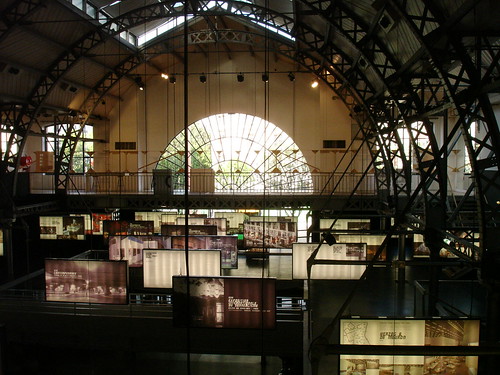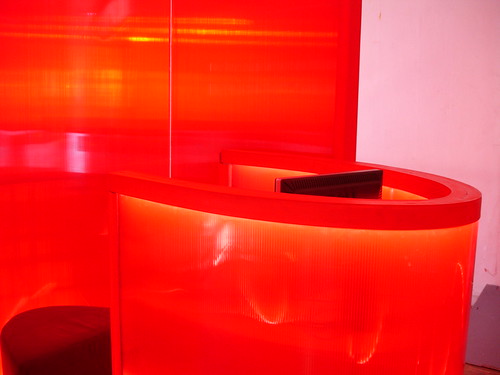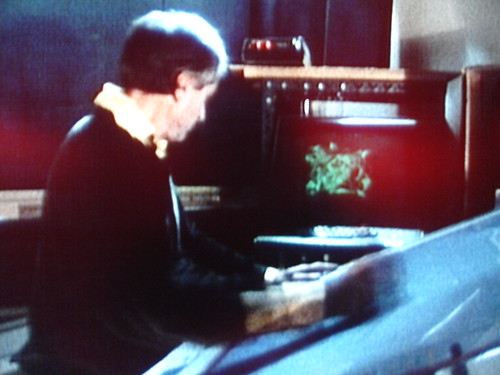pavillon de l'arsenal, videotheque, xenakis again.
The Pavillon de l'Arsenal is a gorgeous building. It's next to the Seine and has a statue recalling Rimbaud near its entrance, and a glass roof. On the ground floor is a story of Paris told through the changing public areas over hundreds of years. Descriptions of urbanity through models, drawings, diagrams, old footage and chronological statistics (daily feature of Parisian life)

Upstairs is an exhibition of architects' exhibitions. Neatly summised in English and French, my favourite of the floating windows (imagine it is a desktop please) was Bruce Mau's pragmatic utopia generation: Too Perfect | Seven new Denmarks. Working in collaboration with Danish architects/designers, they tried reimagining the triple bottom line of economic, social, and ecological sustainability.
His letter "Dear Denmark" is ace. More countries should get open letters. Or maybe colour-coded diagrams. UK could get a myspace page.
Anyway, a few more steps and I was confronted by sticky red booths.

Videotheque! I am loving this word. Not only do they have short slapsticky films on the tramway of 1922 (don't ask) but also big-hitting long-players (Godard et al) and, Xenakis.
Xenakis talking about the U.P.I.C. on French TV to be exact:

Up close:

This page describes the U.P.I.C system pretty well.
We had a voice over telling us he is a "classical greek man" (ha) and then the man himself talking about the genetics of sound, the demise of tradition, the necessity to invent nature, and lastly, how we must go further than nature. (Take note this film was only a few minutes long)
Apparently there is a Windows version of UPIC. Don't know what version Haswell + Hecker used for their project, but here's a section of the tale from Frieze:
Rather than concentrate on simple forms of mark-making and the sounds they produce, they experimented with different types of visual material – tracing onto the UPIC tablet images ranging from news photographs of disasters and atrocities, through depictions of the natural world to microscopic images of molecular structures (such as that which makes up 'the blackest ever black', a coating for telescopes that is purportedly the least reflective material on Earth). Despite the limitations of the system (it won't, for example, allow a full circle to be drawn – a sound that occurs over time can't, after all, travel back on itself), their research was in the spirit of stochastic exploration Xenakis advocated. Haswell and Hecker took the material they recorded at CCMIX and developed it for a diffusion system. No mere PA or surround sound set-up, a diffusion system is a multiple set of speakers that distribute sound through space, and allow for a high degree of real-time control over volume levels, equalization and, most importantly, spatial placement by the operator or performer at the mixing desk.
I want to visit the CCMIX quite badly.

Upstairs is an exhibition of architects' exhibitions. Neatly summised in English and French, my favourite of the floating windows (imagine it is a desktop please) was Bruce Mau's pragmatic utopia generation: Too Perfect | Seven new Denmarks. Working in collaboration with Danish architects/designers, they tried reimagining the triple bottom line of economic, social, and ecological sustainability.
His letter "Dear Denmark" is ace. More countries should get open letters. Or maybe colour-coded diagrams. UK could get a myspace page.
Anyway, a few more steps and I was confronted by sticky red booths.

Videotheque! I am loving this word. Not only do they have short slapsticky films on the tramway of 1922 (don't ask) but also big-hitting long-players (Godard et al) and, Xenakis.
Xenakis talking about the U.P.I.C. on French TV to be exact:

Up close:

This page describes the U.P.I.C system pretty well.
We had a voice over telling us he is a "classical greek man" (ha) and then the man himself talking about the genetics of sound, the demise of tradition, the necessity to invent nature, and lastly, how we must go further than nature. (Take note this film was only a few minutes long)
Apparently there is a Windows version of UPIC. Don't know what version Haswell + Hecker used for their project, but here's a section of the tale from Frieze:
Rather than concentrate on simple forms of mark-making and the sounds they produce, they experimented with different types of visual material – tracing onto the UPIC tablet images ranging from news photographs of disasters and atrocities, through depictions of the natural world to microscopic images of molecular structures (such as that which makes up 'the blackest ever black', a coating for telescopes that is purportedly the least reflective material on Earth). Despite the limitations of the system (it won't, for example, allow a full circle to be drawn – a sound that occurs over time can't, after all, travel back on itself), their research was in the spirit of stochastic exploration Xenakis advocated. Haswell and Hecker took the material they recorded at CCMIX and developed it for a diffusion system. No mere PA or surround sound set-up, a diffusion system is a multiple set of speakers that distribute sound through space, and allow for a high degree of real-time control over volume levels, equalization and, most importantly, spatial placement by the operator or performer at the mixing desk.
I want to visit the CCMIX quite badly.
Labels: architecture, france, paris, urbanism

0 Comments:
Post a Comment
<< Home